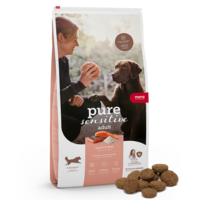Red tinge to the dog’s coat - causes and remedy
If a dog’s coat changes colour, the dog food is the first suspect. But what is the actual reason for this phenomenon? Continue reading to find out more!

Many dog owners will be familiar with the phenomenon:
The coat suddenly has a reddish tinge, while pale-coloured dogs display discoloured areas on the flews (upper lips) and paws. The finger of suspicion immediately points to the ingredients of the food, however this is not sustainable from a scientific perspective.
Discolouration around the flews and paws
Dog saliva contains what are called porphyrins. These are one of the components of haemoglobin and occur in all canine bodily fluids, but especially in saliva and lacrimal fluid. When dogs lick their paws, flews or other parts of the body, these proteins are deposited on the coat and react with oxygen in the air to form a reddish stain. Up to a certain degree, these discolourations are entirely natural and unavoidable. However, if they occur to an excessive extent, you should check with your vet to determine the cause of the dog's elevated saliva production or of excessive licking of specific parts of the body.
Coloured tinges to the coat
Carotinoids and copper are frequently suspected of being deposited on the coat and giving it a reddish tinge. However, this is simply not possible from a chemistry and physics perspective as the fat-soluble carotene cannot be deposited in the protein structure of the hair. The lack of copper actually has the opposite effect: Copper, along with tyrosine, is essential for the development of healthy hair. If one of these two substances is missing, the hair will grow incorrectly pigmented (Zentek & Meyer, 1991).

